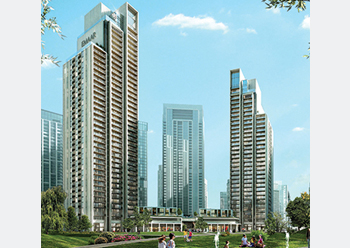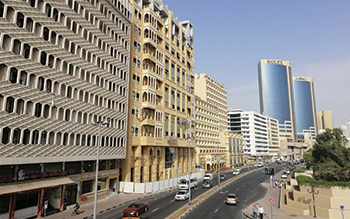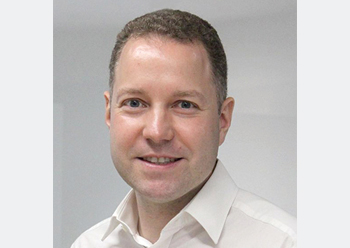
 Baniyas Road Deira Creekside ... traditional buildings stand alongside glaze high-rises.
Baniyas Road Deira Creekside ... traditional buildings stand alongside glaze high-rises.
Sustainability, energy efficiency and resource conservation are buzzwords when it comes to facades and the building envelope. But what is sustainability in relation to the building envelope in the Middle East, and how do we design for it?
In designing sustainable solutions, the challenges are often related to the physical environment, including natural resources, infrastructure, buildings and structures, and urban spaces.
When considering sustainable goals in the Middle East’s building industry, especially with the rapid evolution of codes and regulations, consultants are faced with various challenges requiring new approaches in various fields of façade engineering with regard to sustainable design.
 |
|
Beer |
First off is the climate, which varies from subtropical arid regions to typical Mediterranean atmospheric conditions with the Gulf coast experiencing dominating hot summers and mild temperatures in winter. The characteristics of this region include scarcity of water resources, low precipitation, low biodiversity, excessive exposure to extreme weather events, and desertification.
Given this, it is justifiable to ask what impact the external environment has on occupants, and the main challenges affecting the ecological footprint in a region that has been distinguished by a construction boom for more than a decade. Is it a conflict between traditional building systems matched to its climate or pseudo high-tech?
Nowadays, there is talk about a green building revolution. Red, green and blue arrows underline the drawings of architects to show the greenness of buildings. The aim is to fundamentally change the built environment by creating energy-efficient, healthy, productive buildings that minimise the significant impacts of buildings on urban life and on the local, regional, and global environments.
 |
|
Noureddine |
The growing awareness of global climate change and about the need for high energy conservation in buildings – when compared with other countries – and their total energy consumption has prompted institutes and organisations to engage in promoting sustainability.
The building industry, in particular, consumes more than 40 per cent of the primary energy resources. Most of the building costs occur during occupancy and maintenance and not, as commonly assumed, during the construction phase. A plethora of measures and attempts to save energy in the building sector has resulted in the development of building codes and certification systems.
The introduction of sustainable labels presupposes building codes which are a new challenge for those involved in construction.
Standards that must be achieved for a project are considered mandatory in most industrialised countries and have been promoted lately in newly industrialised countries as well.
Adapting to the local climate conditions was and is the way forward. Great examples of buildings built in the 1970s can be observed in Dubai’s old districts of Jumeirah and Deira.
Deira is one of Dubai’s oldest areas, and the architecture there has been perfectly adapted to its climate. The building façades along the creek in Deira set a perfect example of how protective an envelope can be. The high amount of extreme solar heat gain, which penetrates mostly through the windows, is shielded by external shading devices, such as traditional mushrabiyas and the relatively small number of windows in the design. The windows are also quite set back from the main façade.
Compare these to the modern building envelope, where glass dominates the aesthetics of most of the recently built skyscrapers that dot the skylines.
 |
|
The Green Planet ... featuring a unique indoor tropical rainforest. |
Glass is probably the most sensitive material when it comes to heat transfer. In the Middle East, glass became a popular cladding material following the so-called international style with floor-to-ceiling glazed high-rise towers. Aesthetically, architects often still prefer this style that facilitates a contemporary lifestyle that seeks panoramic views and living spaces flooded with daylight. However, this has to be comfortable when it comes to cooling and glare.
Passive and active cooling methods are slowly being adopted by local authorities and are being considered during the design phase.
Passive cooling methods can include the orientation of the building; south- and west-facing elevations could be treated with fewer openings, while dropping the window-to-wall ratio has already been suggested by authorities; The lesser the area of window, the lower are the strict requirements for thermal performance. For example, a building with a glass ratio of more than 60 per cent has to achieve a higher shading coefficient (0.25) than a building with lesser than 40 per cent ratio (0.4). The shading coefficient of glass is the value that defines the amount of total solar energy (heat) transmittance through the glass.
Other aspects to bear in mind in this regard are visible light transmission (VLT) and shading coefficient (SC) factors, which are linked together – the higher the VLT, the higher the SC.
Solar control low-e coatings, which are relatively new, have a major impact on the solar thermal performance of glass as well as the visual appeal of a building.
Single silver coatings have been in the market for some time, while double silver and triple silver coatings – which are advanced high-performing coatings – are mostly used nowadays to achieve a higher light transmission by reducing the solar heat gain.
High-performance solar control coated glazing reduces solar heat gain through the glass, enabling a reduction of air-conditioning loads and consequently lowering electrical power consumption.
Double and triple silver coatings can both have a similar selectivity and equal performance. Recent findings in the glass industry, however, demonstrate that both coating types perform differently in the so-called g-IR value even if the shading coefficient is identical.
The g-IR value defines the amount of heat transfer (transmittance) within the long-wave radiant heat spectrum of the solar radiation. Different glass colours absorb the heat on the outer pane at different intensities, irrespective of the shading coefficient.
Furthermore, triple silver coatings result in a lower g-IR value compared to single and double silver coatings, even if the coatings seem to have the same performance in terms of SC.
Ramboll has established a research group combining in-house façade engineering and mechanical, electrical and plumbing (MEP) teams to identify the ultimate impact on cooling loads using the newly developed g-IR value.
It was successful in implementing parts of the new glass solar control coating technology for the Green Planet project in Dubai featuring a unique indoor tropical rainforest with more than 3,000 exotic plants and animals.
Here, the glass selection was even more difficult since the solar spectrum needed by plants (greenhouse spectrum) had to be considered and the glass selection adjusted accordingly.
* Ramboll, an engineering, design and consultancy firm, holds sustainability at the core of its organisation and is aware of the responsibility in designing and shaping the built environment. Its ambition is to help drive a sustainable transition towards a more resource-efficient future.
With more than 15,000 experts across 300 offices in 35 countries, Ramboll engineers seek to enhance projects it designs by exploiting new sustainable ways that can significantly reduce resources and energy. Its experts work closely with clients to implement as many sustainable solutions in a project as possible.
With a unique combination of technical excellence and socio-economic insights, Ramboll delivers enduring structures, resource-efficient solutions and socially cohesive communities for today and tomorrow.





















_0001.jpg)


.jpg)
















.jpg)








.jpg)


